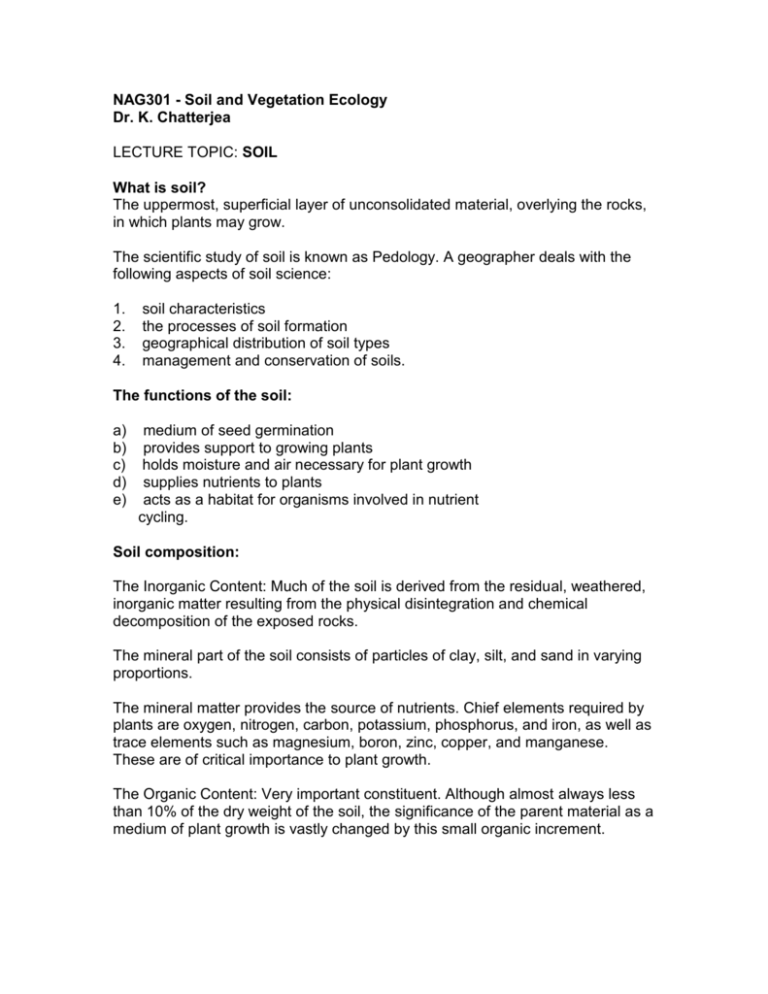Lecture Notes 01: Soil
advertisement

NAG301 - Soil and Vegetation Ecology Dr. K. Chatterjea LECTURE TOPIC: SOIL What is soil? The uppermost, superficial layer of unconsolidated material, overlying the rocks, in which plants may grow. The scientific study of soil is known as Pedology. A geographer deals with the following aspects of soil science: 1. 2. 3. 4. soil characteristics the processes of soil formation geographical distribution of soil types management and conservation of soils. The functions of the soil: a) b) c) d) e) medium of seed germination provides support to growing plants holds moisture and air necessary for plant growth supplies nutrients to plants acts as a habitat for organisms involved in nutrient cycling. Soil composition: The Inorganic Content: Much of the soil is derived from the residual, weathered, inorganic matter resulting from the physical disintegration and chemical decomposition of the exposed rocks. The mineral part of the soil consists of particles of clay, silt, and sand in varying proportions. The mineral matter provides the source of nutrients. Chief elements required by plants are oxygen, nitrogen, carbon, potassium, phosphorus, and iron, as well as trace elements such as magnesium, boron, zinc, copper, and manganese. These are of critical importance to plant growth. The Organic Content: Very important constituent. Although almost always less than 10% of the dry weight of the soil, the significance of the parent material as a medium of plant growth is vastly changed by this small organic increment. Soil Properties: The Mineral Particles: The individual mineral particles of a soil are formed by the weathering of the parent rock. The hard minerals weather to give chemically resistant remains of sand and silt, while the softer minerals weather to form chemically altered products of clay and traces of mineral salts, Soil Texture: It refers to the proportions and amounts of different sized particles, such as sand, silt, and clay in the soil. Particle size affects the properties of soil in several ways. Soil texture is largely an inherited feature of a given soil and depends on the composition of the parent material. The importance of soil texture to plants: Soil texture affects many of the factors which influence plant growth: -infiltration of water -rate of water movement -moisture content and aeration -nutrient retention -root penetration -soil temperature Organic Matter: Important constituent of soil. Humus - a medium for the existence of countless bacteria. There are often three organic layers at different stages of decomposition: litter; duff, and humus. Humus is an end product of organic decomposition. Much of it consists of humic acid in combination with various bases. Humus is important to soils and plant growth. Humification is the process leading to humus formation. The nature of organic matter as well as the rate of its formation vary according to conditions present. Importance of organic matter to plants: -source of mineral nutrients -source of food for most soil organisms -water holding capacity -soil structure -adsorptive capacity -mechanical effects of superficial layers of organic debris Soil structure: This refers to the way in which soil particles are grouped together in a soil. The arrangement of the various-sized clumps are called soil aggregates. The soil structure influences its aeration and moisture content, and the capacity of the soil to resist erosion. The best, structure for plant growth is the crumb structure. Soil Fertility: "Soil Fertility' shows how suitable the total soil environment is for crop growth. A fertile soil should provide soils with air, water, and nutrients in correct amounts and should provide a suitable anchorage for root growth. Soil Formation: Soil is the end-product of a set of processes involving additions, losses, transfers, and transformations of materials. The process of soil formation is called Pedogenesis. The development of soil may be seen as the result of three distinct groups of processes: weathering, addition of organic matter, and movements of water. Weathering processes: They create an accumulation of disintegrated and decomposed parent material. Addition of organic matter: This is the first sign of soil formation, and produces accumulations of organic remains. Movements of water through the soil: Water Budget; climatic conditions and net water flow; movement of soil materials leaching, podzolization, eluviation, illuviation; restricted water flow - gleying. Soils and environment: the soil forming factors -Parent material -Topography -Climate -Biotic factors -Time Soil Profile: used to describe the arrangement of the different layers observable in a vertical section of soil from the surface to the bedrock. The profile usually consists of layers of material differing in colour, texture, and other physical constitution.






